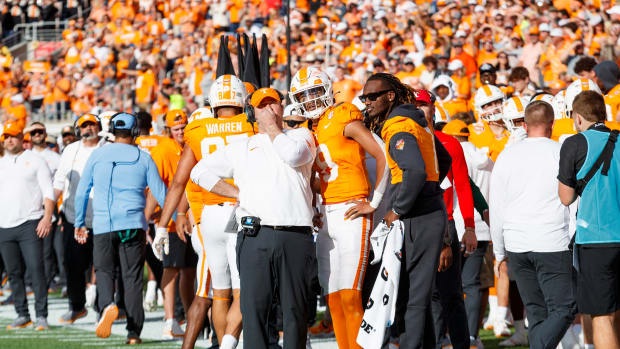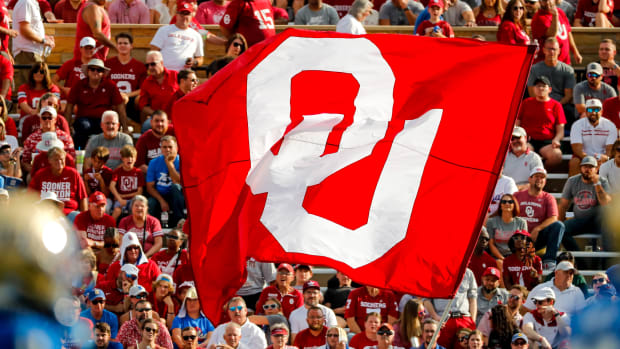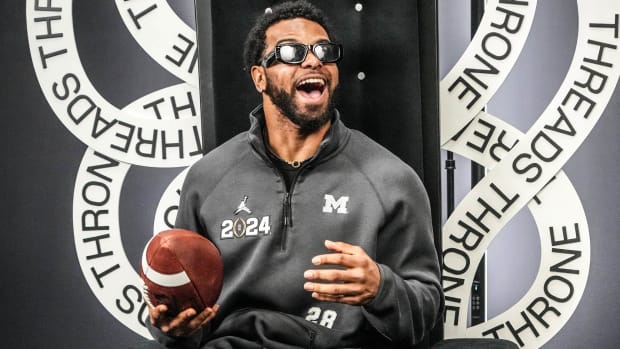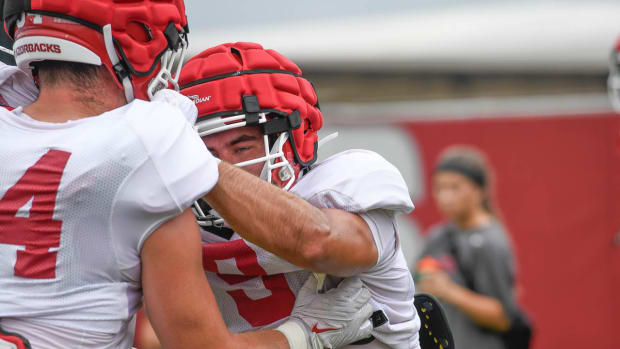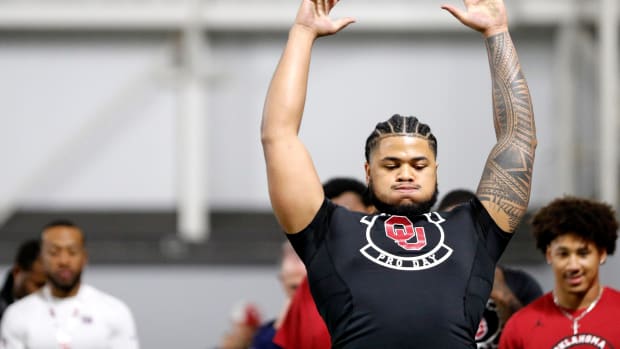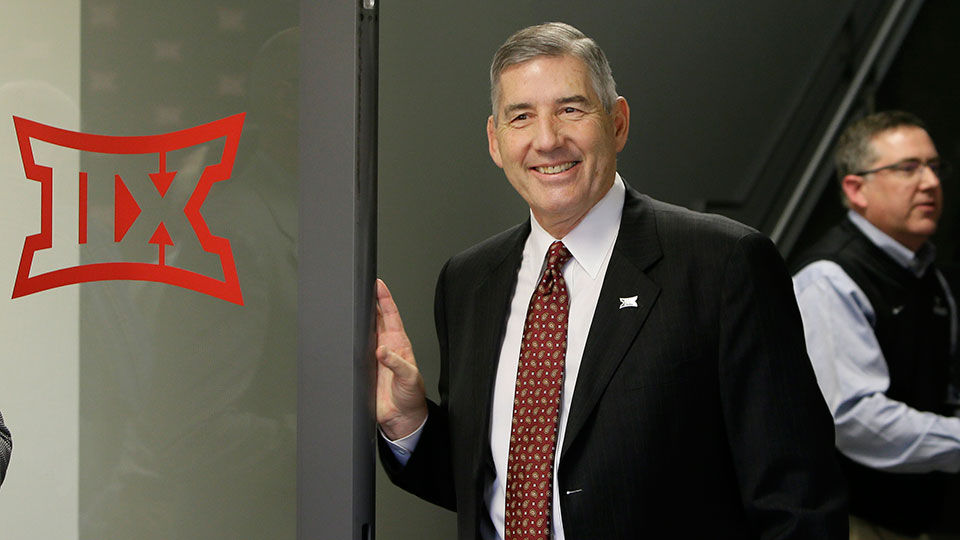
Big 12 examining expansion but missing the point
Get all of Andy Staples's columns as soon as they’re published. Download the new Sports Illustrated app (iOS or Android) and personalize your experience by following your favorite teams and SI writers.
PHOENIX — As Bob Bowlsby tried to explain how the Big 12 would consider its next move, three voices came to mind: a bald kid, Keanu Reeves and former Conference USA commissioner Britton Banowsky.
Which will be the best non-conference games in '16? #DearAndy
Wednesday, Big 12 coaches and athletic directors sat through a presentation from consulting firm Navigate Research that explained the likelihood of the league putting a team in the playoff with various member, divisional and scheduling configurations. That information, which the league’s presidents will see later this month, will help Big 12 members decide whether they want to add schools, add a championship game, split into divisions or some combination of the three. The hope is that league presidents will make some final decisions in June. Oklahoma president David Boren has made it clear he believes the league’s very survival depends on taking two more schools (from a group that probably includes, BYU, Central Florida, Cincinnati, Connecticut, Houston, Memphis and South Florida) and staging a championship game. Others in the league are not so bullish on expansion. They fail to see how any combination of the above schools would help the league make the playoff or close a widening revenue gap between the Big 12 and the Titanic Two (the Big Ten and SEC). Bowlsby is (at least publicly) neutral on expansion, though he does acknowledge the gap because he has eyes and basic math skills.
“If you look at our television and our size and our current contracts and the fact that we don’t have a network and all of those things, the trend lines between us and particularly the SEC and the Big Ten begin to diverge,” Bowlsby said Wednesday. “Who knows exactly how far we’d be behind? But we know we’ll continue to lose ground.”
What does any of this have to do with a bald kid, Keanu and Banowsky? It was another Spoon moment.
In The Matrix, a child tries to reveal to Reeves the peculiar physics of the dystopia they inhabit by teaching him to bend a spoon using only his mind.
Bald kid: Do not try to bend the spoon. That’s impossible. Instead, only try to realize the truth.
Keanu: What truth?
Bald kid: There is no spoon.
I referenced this scene in an October 2011 column after Banowsky and Mountain West commissioner Craig Thompson announced that C-USA and the Mountain West planned to merge. That never happened, but the leagues were open to an extreme idea because a radical realignment storm had left them looking for a safer port. At the time, everyone was viewing the future through the lens of the BCS. At the time, the BCS was the spoon. On that day in 2011, Banowsky suggested that in the future, there might be no spoon.
STAPLES: Problems in the Pac-12?
“Who knows what’s going to happen?” Banowsky asked rhetorically. “I don’t think anyone has a clear idea what will happen in 2014 for sure – whether there will even be a BCS. If there is, who will be in what conferences? What conferences will have access? Will there even be an automatic qualification?"
Almost five years later, we know the answers to those questions. There is no more BCS. There is a four-team playoff. Essentially, five conferences have access. There is no automatic qualification, as the Big 12 learned in 2014 and the Pac-12 learned last season.
Now we have new questions. What if the playoff grows to more than four teams? How many conferences will occupy the top tier of college football? Will conferences look anything like they look now, or will some band together to sell their television rights at a higher price per school than they would have gotten outside the consortium? Now, the spoon is either the playoff format or the conference alignment. The Big 12 may be trying to bend to postseason format that won’t exist as we know it in a few years. Or the Big 12 may be trying to preserve a roster that it can’t possibly hold together in a future conference environment.
The target date for answers is 2023. That’s when the six-year deal the Big Ten just forged with Fox will reach its conclusion. That the deal is so short compared to the deals the other leagues struck around the end of the previous decade and the early part of this one is no accident. The Big 12’s deal with ESPN and Fox ends in 2025. The SEC’s deals with CBS and ESPN end in 2025. The Pac-12’s deals with Fox and ESPN end in 2025. The ACC’s deal with ESPN ends in 2027.
By 2023, or maybe 2025 if the Big Ten opts for a brief bridge deal to allow its deals to terminate along with the Pac-12’s and the SEC’s, we should have some answers. What if, instead of a four-team playoff, there is an eight-team playoff? The lords of the College Football Playoff say in 2016 that they have no desire to expand beyond four. Back in 2009, when they were the lords of the BCS, they said they had no desire to start a playoff. Things change. Meanwhile, the impending end of those television deals — and the attendant Grant of Rights agreements in the ACC, Big 12, Big Ten and Pac-12 — mean we could be looking at a form of realignment free agency.
Heisman Watch: Breaking down the race after spring practice
If Texas officials feel they can make as much or more money in the Big Ten, and ESPN doesn’t feel the Longhorn Network is worth its continued investment, there would be nothing stopping the Longhorns from joining the Big Ten or Pac-12. Oklahoma by itself would probably be wooed by the Big Ten, Pac-12 and SEC. If politically tethered to Oklahoma State, the Sooners and Cowboys could each wind up in the SEC. If the power leagues want to merge their assets and create the most attractive package of media rights to sell — to the networks? to Netflix? to Google? direct to the consumer? — they’ll want to create the most value. As Banowsky reminded us in 2011, there didn’t have to always be six power conferences. There also is no rule saying there must be five. And without Oklahoma and/or Texas, exactly how powerful is the Big 12?
From the moment former Southwest Conference members joined up with Big Eight members, the Big 12 has been a tenuous alliance. Nebraska hated Texas and then left for the Big Ten. Colorado viewed itself as a west coast school and left for the Pac-12. Texas A&M hated Texas and then left for the SEC. Missouri wanted out first (to the Big Ten) but wound up getting out last and going to the SEC. The league doesn’t have anything close to the history of the others, nor does it have their stability.
So will the Big 12’s presidents attempt to rearrange some deck chairs? Or will they stand pat? One factor Navigate Research’s modeling probably didn’t take into account was the fact that one or two great coaches can change everything. Going to 12 teams with two divisions, eight conference games and a championship game might offer a slightly better chance of making the playoff, but how much better does Nick Saban make the SEC’s chances? How many percentage points does Urban Meyer add for the Big Ten? Remember, we’re probably not even talking about expansion if TCU doesn’t collapse against Baylor in 2014 or Ohio State beats Wisconsin 17-14 instead of 59-0.
The overreaction to the Big 12’s omission that first year has driven the expansion push in certain corners of the conference. The financials relative to the Big Ten and SEC don’t look good, either, but they also don’t take into account the third-tier rights deals that each Big 12 school cuts independently of the conference deal. The most famous of those is the Longhorn Network, which brings in $15 million a year for Texas. Oklahoma’s third-tier deal with Fox brings in an average of about $6 million a year. All of the Big 12’s third-tier deals are worth at least $3 million a year. Add those to the $23 million a year each school gets from the Big 12’s first-and second-tier deals and bowl tie-ins, and the gap isn’t as dramatic. That doesn’t mean it’s non-existent. Each SEC school received $31.2 million from the league last year, and that number should be bigger this year because the SEC Network hadn’t been in operation for a full year when the disbursement was made last year. The Big Ten still has to make a new second-tier deal, but if its recently forged $250 million-a-year first-tier deal with Fox is any indication, schools should be receiving more than $40 million each once the new deals commence.
Where does that leave the Big 12? We don’t know. Common sense suggests adding from the list of schools above won’t convince network partners to raise the per-school amount they pay.* This is a lousy time to negotiate a TV deal, because cable networks have no idea what their future holds. This is why they are paying top dollar for can’t-miss rights and very little for the rights of leagues and events that have limited fanbases.
*Absent a clause that forces them to keep the pro-rated payment the same, ESPN and Fox might not make a new deal in this climate that pays what the Big 12’s deal pays now. But that clause exists, so current schools would not have to give up TV money to add schools. They might, however, have to give up bowl money.
If enough Big 12 presidents are confident that keeping the membership at 10 wouldn’t significantly harm the league’s chances of making the playoff, remaining lean and nimble might be to the league’s benefit. What if Oklahoma or Texas or TCU or Baylor or some combination won a few national titles between now and the termination of the media rights deals? Suddenly, the Big 12 would be hot. Maybe schools from the Pac-12 or ACC might see a brighter future there. The ACC and the Big East were considered equals before the last round of realignment. The difference was that instead of playing defense, ACC commissioner/ninja John Swofford gutted the Big East by taking Boston College, Miami, Virginia Tech, Syracuse and Pittsburgh. Now one conference is in the Power Five, and one has split into a middle-class league (the American Athletic Conference) and a football-free league (the Big East).
THAMEL: Can Charlie Strong turn Texas around in Year Three?
No one that could significantly strengthen the Big 12 wants to join the Big 12 right now. But in 2023? Maybe? Or maybe the Big 12’s most valuable would prefer to go elsewhere.
So instead of staring at the spoonful of data that explains how things are in 2016, Big 12 presidents need to understand that in only a few years, there may be no spoon at all.
